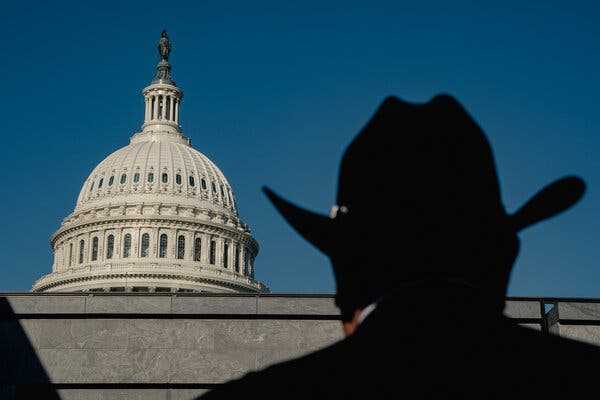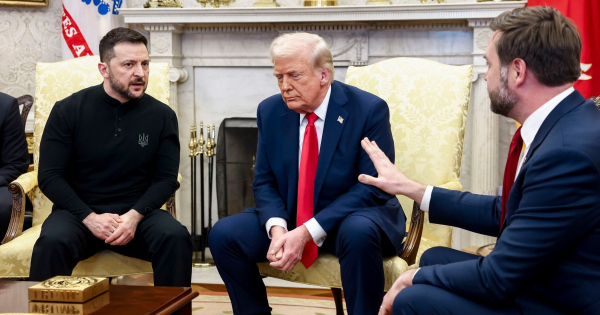Estimates put the amount of leftover money between $50 billion and $70 billion. But even if Republicans could claw it back, it would not make much of a dent in the deficit.
-
Send any friend a story
As a subscriber, you have “>10 gift articles to give each month. Anyone can read what you share.
Give this article

House Republicans are considering a proposal to recall billions of dollars in unspent coronavirus relief money.
WASHINGTON — House Republicans demanding spending cuts in exchange for raising the nation’s debt limit have rallied around a seemingly straightforward proposal: recalling billions of dollars in coronavirus relief funds that Congress approved but have not been spent.
Top Republicans regard the idea of rescinding unspent pandemic emergency money — an amount estimated to be between $50 billion and $70 billion — as an easy way to save money while avoiding more politically perilous options like cutting funding for popular federal programs. Their focus on the idea reflects how, after toiling unsuccessfully for months to unite their rank and file around a fiscal blueprint, G.O.P. leaders have become acutely aware that they have few options for doing so that could actually pass the House.
On Wednesday, Speaker Kevin McCarthy highlighted the measure when he finally unveiled House Republicans’ proposal to raise the debt limit for one year in exchange for a series of spending cuts and policy changes. The party plans to vote on the legislation next week.
“The American people are tired of politicians who use Covid as an excuse for more extreme inflationary spending,” Mr. McCarthy said in a speech on the House floor. “If the money was authorized to fight the pandemic, what was not spent during the pandemic should not be spent after the pandemic is over.”
But going after the leftover money scattered across the patchwork of government programs used to dole out the relief funding — dozens of different accounts — is easier said than done.
And even if House Republicans can find a way to identify and get their hands on the comparatively small sums of leftover money, it would do little to shrink the nation’s $1.4 trillion deficit. Additionally, the federal budget analysts who calculate the deficit have already accounted for the fact that some of the money Congress allocated for pandemic relief programs will likely never be spent.
House Republicans have identified the move as just one way to rein in federal spending, which they say must be done in exchange for their votes to raise the debt ceiling, which is expected to be breached as early as June.
But the challenges around what has widely been considered one of the simplest options underscore how difficult it will be for the party to meet the lofty goals Republican leaders laid out at the beginning of the year. They have already abandoned their aspiration of balancing the federal budget in 10 years and have been unable to reach consensus on freezing spending levels and other cuts that would shave down the deficit without touching Medicare or Social Security.
ImageCredit…Jeenah Moon for The New York Times
Over the span of two years and six laws, Congress approved about $4.6 trillion in federal spending to help the nation respond to and recover from the coronavirus pandemic. While most of that money has already been spent, either by federal agencies or state or local governments, tens of billions of dollars have yet to be earmarked for specific use.
An internal document circulated by House Republican leaders laying out a draft of their fiscal demands in exchange for raising the debt limit until May 2024 estimated that there is $50 to $70 billion in leftover federal coronavirus relief funds scattered across federal agencies and programs. The Government Accountability Office reported in February that there was about $90 billion remaining.
Understand Biden’s Budget Proposal
President Biden proposed a $6.8 trillion budget that sought to increase spending on the military and social programs while also reducing future budget deficits.
- Recapturing a Centrist Identity: Biden has made curbing the budget gap one of his centerpiece promises. The move is part of a wider shift that sees the president speaking more to the concerns of the political middle.
- Reducing Deficit: Instead of talking about hard choices and freezing spending, the president has pledged to defend popular federal programs and rely on taxing corporations and high earners. That represents a break with the past.
- A Missing Plan for Social Security: Like the president’s previous budgets, his new proposal makes no mention of the program, which he promised to shore up during his 2020 campaign.
That money is spread across dozens of programs, and many agencies are still doling out money, including the Health and Human Services Department, the Department of Veterans Affairs and the Transportation Department.
The bulk of it is intended for grants to health care providers, medical care for veterans, pension benefits and aid for public transit agencies that saw ridership levels plummet during the pandemic. Although Biden administration officials expect much of the remaining funds to be spent eventually, officials believe some programs with leftover money are largely over, including one designed to help aircraft manufacturers pay for compensation costs during the pandemic, which had about $2.3 billion left as of January.
The funds could be unspent for various reasons. Transit agencies could already be using some to fund operations, but may not have submitted reimbursement requests to the federal government because they have more than a year left to spend the money. Funds for public health have been set aside for research, vaccine distribution and refilling stockpiles of personal protective equipment. A program that provides assistance to financially troubled pension plans is accepting applications through 2026 because of its extensive review process.
Economists and policy researchers said rescinding the unspent funding would help trim the deficit — but only by a relatively small amount.
Even if lawmakers were able to rescind, for example, $70 billion in relief funds, it likely would not result in a $70 billion reduction of the deficit, according to economic researchers. That is because researchers at Congress’s nonpartisan Congressional Budget Office who project the deficit have already assumed that not all pandemic relief funds would be spent and factored that into their calculations.
Douglas Holtz-Eakin, the president of the conservative American Action Forum and a former C.B.O. director, said it would “make good sense” to rescind unspent relief funds if there were a substantial amount left and they were not needed, but the total savings would be relatively scant. He argued that it would be more effective for lawmakers to instead focus on slowing the growth of benefit programs such as Social Security or Medicare.
“If you’re genuinely worried about the fiscal future and the unsustainable nature of the federal budget, good, but this won’t solve any of those problems,” Mr. Holtz-Eakin said. “This is a one-time reduction in spending that looks backward, not forward, and the real issues are in front of us.”
Marc Goldwein, the senior vice president at the Committee for a Responsible Federal Budget, a nonpartisan fiscal watchdog group, said the federal government should pursue some of the relief money that is not being used and try to recoup funds by investigating cases of potential fraud, though it would be a “little too late” now.
“We shouldn’t have a bunch of money sitting out there that’s not being used if it’s not needed, but we just shouldn’t expect much budget savings from it,” Mr. Goldwein said.
The White House has pushed back on the proposal and signaled that it would not support a move to rescind a significant amount of the funds.
Gene Sperling, a senior White House adviser, said that about 98 percent of the funding in the $1.9 trillion American Rescue Plan has already been spent or is “on the train to go out to people and places as it was specifically intended to by the law.”
Rescinding the unspent funds, he said, would “lead to significant pain for veterans, retirees [and] small businesses.”
Image“This is a one-time reduction in spending that looks backward, not forward, and the real issues are in front of us,” said Dr. Douglas Holtz-Eakin, the president of the conservative American Action Forum and a former C.B.O. director.Credit…Stefani Reynolds for The New York Times
Congressional negotiators have previously attempted to offset the costs of other bills by rescinding unspent Covid money provided to state and local governments, including last year, when Democrats tried to cover the cost of a $15 billion pandemic relief bill in part by rescinding funding earmarked for state and local relief funds.
But a revolt from Midwestern House Democrats — whose states would have been disproportionately affected by the clawbacks and whose governors yowled at the idea of being stripped of money they had already planned to use — ultimately led party leaders to drop the measure altogether.
The episode served as a warning to state and local leaders, and ahead of the debt limit fight, some prominent mayors began publicly warning their peers to spend down the federal funds available to them quickly.
Lawmakers last year also sought to offset the costs of the stand-alone pandemic aid bill by raiding the $2.3 billion in unspent money from the Transportation Department’s program to help aircraft manufacturers cover the costs of their employees’ wages during the pandemic. The idea was ultimately scuttled after the revolt around rescinding state and local funds.
Source: nytimes.com



